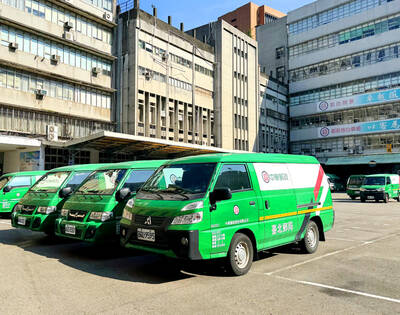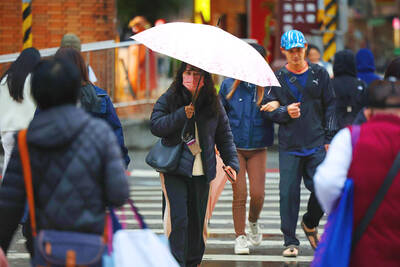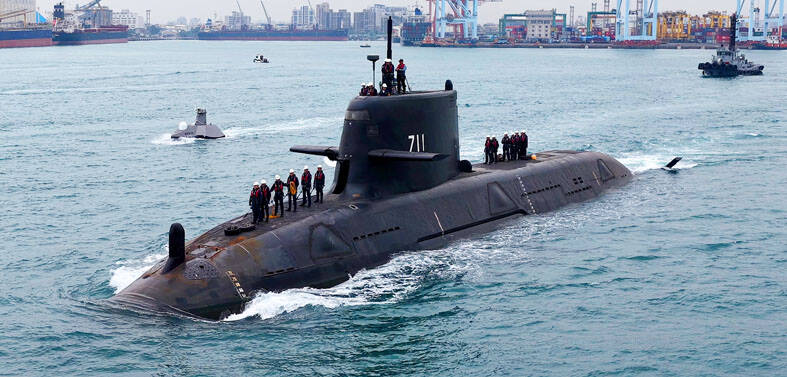Wu Chen-yao (吳禎耀) can still recall his teenage days when he played in the Green River (綠川), a 6.1km canal that runs through Taichung’s Central District (中區).
“There were all kinds of fish — tilapia, eel — and we would go into the water to catch them, while our mothers washed clothes there,” said Wu, the 67-year-old warden of the district’s Jiguang Borough (繼光).
The district is the birthplace of Taichung’s cultural and economic activities, which is crossed by two major canals — Green River and Willow River (柳川).
However, local residents usually just call them “ditches” due to the heavy pollution caused by household and industrial wastewater as a result of Taichung’s industrialization in the 1980s.
As more people moved out of the district in the 1990s, when urban development spread westward, the canals received even less attention, apart from complaints about their smell.
However, things have been changing since 2014 under a government-led project to revitalize the district.
A 17-month Green River renewal plan was recently completed and the river reopened to the public on Feb. 10, following a similar project with the Willow River from 2014 to 2016.
The initiatives are aimed at improving the canals’ water quality and flood-prevention capabilities, as well as creating a water-friendly environment to make the old district more attractive, Taichung Water Resources Bureau Director Chou Ting-chang (周廷彰) said.
“The management of the waterways determines a city’s destiny,” he said. “We want to restore the reputation of ‘Little Kyoto’ for the old downtown.”
Urban development in Taichung, which started in 1900 during the Japanese colonial period, was modeled after the Japanese city of Kyoto, known for its beautiful rivers and checkerboard-style streets.
Renovation work started with the Willow River, as it has a more spacious environment and less traffic, Chou said, adding that the pilot project was then used to solicit public feedback and make adjustments to the Green River project.
Facilities were established in both canals to divert polluted water to nearby sewage treatment plants before being released back into the waterways, he said.
These methods have led to significant improvement in the canals’ water quality, the bureau said.
Citing the river pollution index, the bureau said that the Willow River’s reading dropped from 9 to 2.75, while the Green River’s fell from 8.25 to 2.75 — meaning their pollution status has been downgraded from severely polluted to lightly polluted.
To create a friendly environment for residents, the bureau has designated stretches of 300m and 610m along the Willow River and Green River respectively for pedestrian walkways.
The government went a step further with the just-completed Green River project by applying a trademark for the canal, the first of its kind in the nation, as well as holding an exhibition to promote the waterway and the Central District.
Iehihuku, a 90-year-old bakery in Taichung, launched a Green River-themed pastry, while commemorative “Green River beers” and “Green River red envelopes” are on the market as well.
An exhibition is under way until March 11 featuring works by artists using their five senses to describe what they feel about the river.
While the canal renovation projects have been lauded by the public, there are still issues that need to be adddressed.
“Yes, the water is a bit cleaner and the environment is better, but I am not sure how long the Green River and its trademark will interest people so they will keep coming back to the area for tourism or shopping,” Wu said.
Grace Lin (林秀娟), who has witnessed the canals’ transformations, said that there is not enough water-friendly space, diverse facilities and integration of nearby tourism resources in the renovation of the Willow River.
There are other complaints, including that the budget — NT$370 million (US$12.7 million at the current exchange rate) for the Willow River and NT$850 million for the Green River — was too expensive.
Chou said that construction of scenic spots along both canals, which will feature their nearby communities, are continuing.

SHIPS, TRAINS AND AUTOMOBILES: The ministry has announced changes to varied transportation industries taking effect soon, with a number of effects for passengers Beginning next month, the post office is canceling signature upon delivery and written inquiry services for international registered small packets in accordance with the new policy of the Universal Postal Union, the Ministry of Transportation and Communications said yesterday. The new policy does not apply to packets that are to be delivered to China, the ministry said. Senders of international registered small packets would receive a NT$10 rebate on postage if the packets are sent from Jan. 1 to March 31, it added. The ministry said that three other policies are also scheduled to take effect next month. International cruise ship operators

NUMBERS IMBALANCE: More than 4 million Taiwanese have visited China this year, while only about half a million Chinese have visited here Beijing has yet to respond to Taiwan’s requests for negotiation over matters related to the recovery of cross-strait tourism, the Tourism Administration said yesterday. Taiwan’s tourism authority issued the statement after Chinese-language daily the China Times reported yesterday that the government’s policy of banning group tours to China does not stop Taiwanese from visiting the country. As of October, more than 4.2 million had traveled to China this year, exceeding last year. Beijing estimated the number of Taiwanese tourists in China could reach 4.5 million this year. By contrast, only 500,000 Chinese tourists are expected in Taiwan, the report said. The report

Temperatures are forecast to drop steadily as a continental cold air mass moves across Taiwan, with some areas also likely to see heavy rainfall, the Central Weather Administration (CWA) said. From today through early tomorrow, a cold air mass would keep temperatures low across central and northern Taiwan, and the eastern half of Taiwan proper, with isolated brief showers forecast along Keelung’s north coast, Taipei and New Taipei City’s mountainous areas and eastern Taiwan, it said. Lows of 11°C to 15°C are forecast in central and northern Taiwan, Yilan County, and the outlying Kinmen and Lienchiang (Matsu) counties, and 14°C to 17°C

STEERING FAILURE: The first boat of its class is experiencing teething issues as it readies for acceptance by the navy, according to a recent story about rudder failure The Hai Kun (海鯤), the nation’s first locally built submarine, allegedly suffered a total failure of stern hydraulic systems during the second round of sea acceptance trials on June 26, and sailors were forced to manually operate the X-rudder to turn the submarine and return to port, news Web site Mirror Daily reported yesterday. The report said that tugboats following the Hai Kun assisted the submarine in avoiding collisions with other ships due to the X-rudder malfunctioning. At the time of the report, the submarine had completed its trials and was scheduled to begin diving and surfacing tests in shallow areas. The X-rudder,